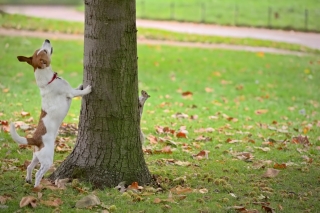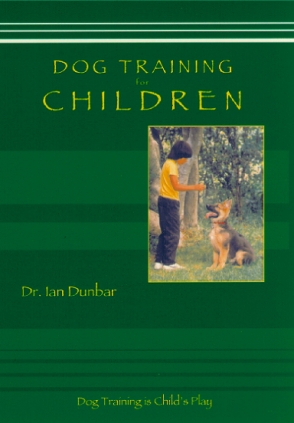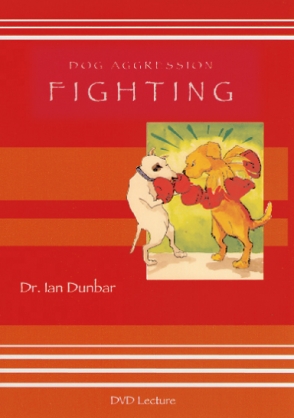When puppyhood collides with adolescence... you need different training techniques. Successful adult dog training requires controlling the dog’s energy and reactivity to regain attention.
Barking Up the Wrong Tree

Why so much learning theory doesn’t work too well in practice.
An applied learning theory is essential for teaching/training all animals, people included
These days we are being increasingly advised that dog training should be based on peer-reviewed, published studies. I feel this is a bit silly because there are so few research studies on dog training. In fact, there are next to none. Certainly, there are wonderful studies on the behavior of wild canids, on feral or free-roaming domestic dogs and there are some really interesting studies on cognition in companion dogs but … there just isn’t much on people training companion dogs.
All too often these days when we suggest a solution, sometimes even a solution that has worked with a couple of thousand dogs, we hear the retort, “Is there a study on that?” No there isn’t. And there won’t be until dog trainers start doing their own research. It’s easy. You already have the experimental subjects in class every week. All you need do is keep performance records. For each exercise, we must have well-established benchmarks for Time and Trials to Criterion, so that we fully understand our own capabilities and can offer dog owners a realistic prognosis in terms of time and dollars to resolution.
We are advised to base our methods on the large knowledge base from learning theory — hundreds of thousands of studies. Certainly, learning theory is a well-established science. So many experiments with the same results can’t be wrong. But the big question is: How relevant are these findings to companion dog training. And the answer: Not much.
Punishments?
The vast majority of learning theory experiments were conducted by computers and performed on captive rats. Now, I don’t want to be “rat-ist” but dogs really are a little bit different. Additionally, there are two important differences between training captive animals and animals at liberty:
1. Professor Mark Rosenzweig once made a thought-provoking statement that all the physiological and psychological experiments performed on animals raised in cages, (i.e. nearly all studies), constituted “research on animals with stunted brains!” Most likely, the rats were somewhat harder pushed to come up with creative solutions for getting more food or escaping punishment.
2. Indeed, captive animals cannot escape punishment. This is one of the reasons why punishment was so successful in laboratory studies, which then, prompted animal trainers and people-teachers to follow suit. Punishment training was taken as gospel. Yes, punishment can be effective on captive trainees (in cages, cells, offices, classrooms and sadly, homes) but in the real World, the animal can run away, or just walk away, from training and the trainer, the prisoner can escape, the employee can quit, the child can play truant, or leave home. Or, the animal can convince the trainer to run away.
Even so, when people train animals or teach other people, punishment is simply, just not very effective, and, the process is usually extremely time-consuming. The biggest myth in training/education is: That punishment is a quick fix. In reality, relying on punishment is not particularly quick, neither is it a fix! This may sound counter-intuitive to some of you.
So …What are the reliability glitches with punishment?
For punishment to be effective, the animal must be immediately punished each and every time it misbehaves. Computers accomplish this directive admirably in the laboratory, immediately and consistently punishing each “transgression” with shock, 24/7. But people are NOT consistent. And if a trainer misses just one instance of misbehavior, the animal will learn that it may safely misbehave in similar situations, e.g., when off-leash and at a distance, when the owner is away from home, or at home but watching TV, checking email, or taking a shower, when the teacher is out of the classroom, when a spouse is out of town, A single inconsistency creates a much more difficult problem to resolve — trainer-absent misbehavior.
(In fact, it was my decades-ago quest for ways to punish dogs in the owner’s absence that lead me to the realization that punishing dogs for most misbehaviors was not a smart educational move at all. Instead, the quest should have been: 1. How to set up situations so that dogs can only get it right and 2. How to REWARD dogs for desirable behavior whether the owner is present or not. Hence, stuffing Kongs with food — a lightbulb epiphany that nattily prevents/resolves destructive chewing, excessive barking and separation anxiety and facilitates housetraining.)
The really wonderful thing about reward-training though, aside from being fun of course, … you can be inconsistent when praising/rewarding and the animal still learns. In fact, even a random reinforcement schedule is better at maintaining rates of responding than say, more laborious, continuous, or fixed-rate schedules of reinforcement.
Rather than universally proselytizing, “You have to be consistent!”, when are we going to acknowledge, people are inconsistent and so, design quick, easy and effective dog training techniques for inconsistent people? Hello there, Reward-Training!
And … Why is punishment training time-consuming?
Reward-training is pure in its simplicity and effectiveness. Teach the animal what you would like it to do and reward. Since there is only one right way, this takes only a finite amount of time. On the other hand, there are an infinite number of ways and situations in which a dog could misbehave — each requiring immediate punishment. Hence, punishment-training takes an infinite amount of time. And to state the obvious, infinite is longer than finite.
Yup! It’s extremely challenging to teach/train effectively, using punishment, which raises a much bigger issue: Are punishments punishments?
We assume that a raised voice, grab, shake, alpha-rollover, leash jerk, horse twitch, cattle prod, elephant hook, or shock are punishments, but are they? A punishment is often defined as: “A stimulus that causes the immediately preceding behavior to decrease in frequency, such that it is less likely to occur in the future”, i.e., a punishment is not defined by its nature (aversive or non-aversive), instead a punishment is defined by its effect on behavior — the frequency or intensity of behavior. Consequently, if punishment is effective, as training proceeds, the frequency of misbehavior and hence, the frequency of punishment, should progressively decrease to zero. If not, then the aversive stimulus is not a punishment. OK! Then … What is it?
Rewards?
Enough about punishment, so what about Reward-Training? Well, Rewards are also defined by their effect on the frequency and nature of behaviors. But when we quantify the reinforcing nature of different Reward-Training methods in terms of Time and Trials to Criterion, (e.g., a verbally cued 1-minute Stand Stay, or a single-command, 3-second, dog park recall), we realize that both the speed and effectiveness (reliability) of training have decreased considerably over the past decade and so, presumably, the power of the reinforcement schedules and/or, the power of the rewards themselves, have also decreased. Essentially, many rewards are no longer very reinforcing. Why not? Basically, far too many people use too far too many food rewards and too little praise or other high-value, mega rewards.
Lure/Reward Training, in particular, has crashed and burned. People are devaluing food rewards by using too many and not phasing them out. When compliance drops (usually in adolescence), kibble is replaced by treats, then comes a quest for tastier treats and then, Zoom! … we slide down the slippery slope to bribing, or more accurately, trying to bribe the dog for slow, sloppy and occasional responses. Yikes! OMW! Does Reward-Training need a makeover.
When done correctly, Lure/Reward Training is the third easiest but absolutely the quickest and most effective reward-training technique for teaching prompt, reliable, cued-responses. So, … What’s gone wrong?
Reinforcement Schedules
I don’t believe we are even talking about, let alone still using the lame (relatively ineffective) reinforcement schedules prescribed in laboratory learning theory. Yes, this was peer-reviewed, published research but a lot of it is nearly 100 years old, doesn’t really relate to the real doggy world and certainly doesn’t have the power to train a puppy, let alone an over-the-top, out-of-control, adolescent, Shiba-Basenji-Malinois cross.
With Continuous (Consistent) Reinforcement, after only a brief, initial blip of wonder, both the rates of responding and the quality of responses crumble. So, “What’s the hurry? Why exert myself? I know I’ll always be rewarded. The reward will wait.” The Fixed Schedules aren’t much better because they are predictable. No puppy trainer in their right mind would use these schedules, yet amazingly, the world’s entire workforce is maintained on FI (Payday) and FR (Piece Rate) schedules!?! Neither are particularly motivating. Certainly, the Variable Schedules maintain rates of responding much better but they are much too difficult for trainers to compute when training a dog and they are not much more effective than plain old Random Reinforcement.
But the real silliness? In terms of the qualitative aspects of behavior, all of these reinforcement schedules (CR, FI, FR, VI, VR, and RR) reinforce just as many below-median responses as above-median responses! Duh! What about quality control? What about Differential Reinforcement? At the very least only reward above-average responses, and maybe offer better rewards for better responses and the very best rewards for the very best responses, so that the dog’s behavior continually improves. We need to quantify both the quantitative and qualitative aspects of responses and reward the dog accordingly, e.g., a DR-10.20.30 that was designed to teach a couple of Berkeley Bassetts blazingly fast recalls.
The Nature of Rewards
Back in the day, we would hear enthusiastic and exuberant praise, laughter and giggles as people patted and petted their dogs and danced a Jolly Routine to celebrate stellar performances; and we saw life-rewards, such as sniffing and playing; and games, such as fetch, tug, and tag; and the dog’s favorite activities — cued “problem” behaviors — such as “Jazz-up” (hyper-craziness), “Give us a Hug” (jump-up), “Speak” (Woof! Woof!! Woof!!!) and for my Malamute, Omaha, “PULL!!!”, to celebrate beyond-stellar performances. Training was truly a joy to behold.
Now we get a single treat. Or, a click and a treat? Training has become clinical, quiet and slow. So very quiet. Laboriously slow. And when we add in “relatively boring” and “unnecessarily complicated”, no wonder we’re in trouble. Dog training is in danger of losing its effectiveness, its magic, its voice, and its soul.
Binary Feedback + Instructions!
Researchers came up with a simple mantra for changing behavior, “Reward vs. Punishment” and they pretty much flogged that horse to death. Well, it wasn’t what we needed 100 years ago, and it’s not what we need right now.
The Reward bit was pretty much OK, except that: 1. Many people have difficulty praising, or rewardingly convincingly (appropriately), which of course, is why it’s smart to let the dog reward itself for desirable behavior; and 2. Rewarding/Punishing the dog after the response neglects perhaps the most important aspect of education — Instruction beforehand. Training is just so much quicker if the trainee knows what to do.
In the dog training world though, the Punishment moiety literally ripped the lid of Pandora’s Box and pushed emotional buttons that cleaved the field of dog training into two groups that stopped listening to and learning from each other.
Now, as I have said, punishment doesn’t work too well in the real world, but, even if it did, punishment is so woefully insufficient. Punishment may inhibit undesirable behavior but does very little to get the dog back on track again. When dogs are non-compliant or otherwise misbehave, it is essential that the trainer’s feedback is instructive and communicates three pieces of information: 1. The current behavior is undesirable, 2. Which specific behavior is desired, and 3. The level of danger of non-compliance, or misbehavior. This may only be accomplished via verbal feedback.
Rather that 1. Reward vs. 2. Punishment, I much prefer:
1. Teach What to do on verbal cue and effectively Reward
And in the case of non-compliance,
2. Short-term — Repetitively Reinstruct (calmly insist until the dog complies and then repeat entire exercise over (and over) until the dog complies following a single verbal cue.
2. Long-term — Go back and Retrain and EFFECTIVELY Reward the cued behavior, i.e., mega-motivate the dog to Want to comply.
Or, in the case of misbehavior,
2. Short-term — Issue a single instruction that terminates the undesirable behavior and immediately gets the dog back on track (e.g., “Sit!”, “Shush!”, “Kong!”, “Bed!”, etc.) and then praise.
2. Long-term — if the above works, well done, continue what you’re doing, if not, go back and retrain the dog to Want to sit, shush, get a Kong, and/or go to its bed, etc.
What Does the Dog Training Profession Need?
Laboratory learning studies were so remote from addressing the more important issues in companion dog training, i.e., what people need?
1. How can I teach my dog to thoroughly enjoy the company of all people, especially children, and to never harm a person, or other animal, even when provoked or hurt?
2. How can I easily and quickly teach my dog to live in my house (and garden) without annoying me, i.e., preventing predictable behavior problems?
3. How can I teach my dog to respond to verbal cues promptly, reliably and happily, when off-leash, at a distance and distracted, i.e., on walks, in parks and at home?
So, what do we need? What should be the basis of modern-day dog training?
Dog trainers (and owners) so desperately need an Applied Learning Theory, i.e., about Dog Training: How to increase/decrease the frequency behaviors; How to increase the reliability of cueing desirable behaviors, or terminating undesirable behaviors: How to progressively improve qualitative aspects of responses — speed, length, precision, panache and pizazz.
My recommendations:
A. We should ditch the entire vocabulary of conventional learning theory. Take “the quadrant” for example. (Please!) I only promoted the quadrant because it was an easy way for people to understand (and remember) the Positive/Negative – Punishment/Reinforcement confusion. (Actually, if you want a good laugh, read Skinner’s paper stating that scientific terminology should be clear and unambiguous and easily understood by the layman.) Technical terms and acronyms only make it more difficult to teach owners (and other trainers) how to train. I much prefer the simpler and more instructive: “1. Say, Sit”; 2. Lure the dog to sit and … 3. When the dog sits, 4. Praise and maybe pet, or say, Tug”, “Fetch”, “Go Sniff”, or “Go Play”
B. We need to rank order all of our exercises (training tools) in terms of speed, ease, and effectiveness and quantify each exercise, so that trainers can objectively evaluate their training skills, i.e., how quick, how easy and how effective are their techniques.
C. Oh yes! Absolutely. We need applied research on dog training conducted by dog trainers. We need quantified benchmarks, for example, the expected time required to teach a 3-minute down-stay, a 90% reliable, single-cue, park recall, or to walk a prescribed course without tightening the leash once.
Years ago, I started the APDT Foundation to establish an online Journal of Dog Training Research conducted by dog trainers. Grants for scientists at institutions to conduct studies that might be peer-reviewed and published was a very secondary aim. What I had in mind were cash-money prizes for research studies by trainers that were already completed.
Research on Dog Training
Decide what you are going to quantify: Response Reliability %s, Response:Reward Ratios, and Response:Punishment Rations. Whether it’s better to score Best Responses (personal bests — quickest recalls, longest stays, etc.), or Average Responses, or Time and Trials to Criterion (e.g., 1-minute Sit-Stay, 3-minute Down Stay, S-D-S-St-D-St Position Changes with Luring, Handsignals only, or Verbal only).
Initially, use each dog as its own control. Matched Control Groups will not be necessary. Neither will statistics. Unlike most research, Dog training Research produces definitive, robust and reproducible results. Training is about behavior change and so, when you graph out Before-and-After results, you can see the Effect — the Change — on a single sheet of paper from across the room. However, if you would like to analyze the results with statistics, the p values will all be less than 0.01, i.e., pretty certain. (I’ve read medical studies with a p-value of .5, i.e., there was a 50% likelihood that the results were chance.)
All training needs to on video — real time, i.e., with no cuts, so that anyone else can count the numbers.
Once these benchmark studies are published, some trainers will look at the results and watch the video and say, “Wow! That’s incredible! I’m going to try it that way!”, or, “Nhah! I could do better than that. I’m going to do my own study.” Then, and only then, will we know which trainers to listen to and learn from, and which trainers to praise and encourage, (they did a study), yet otherwise, politely ignore most of what they did.










